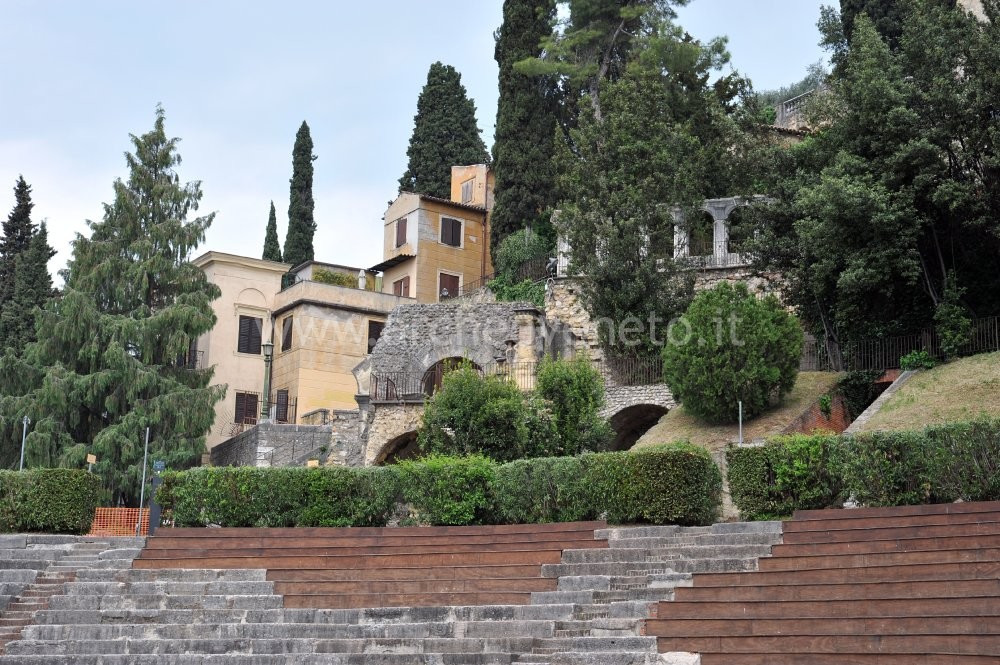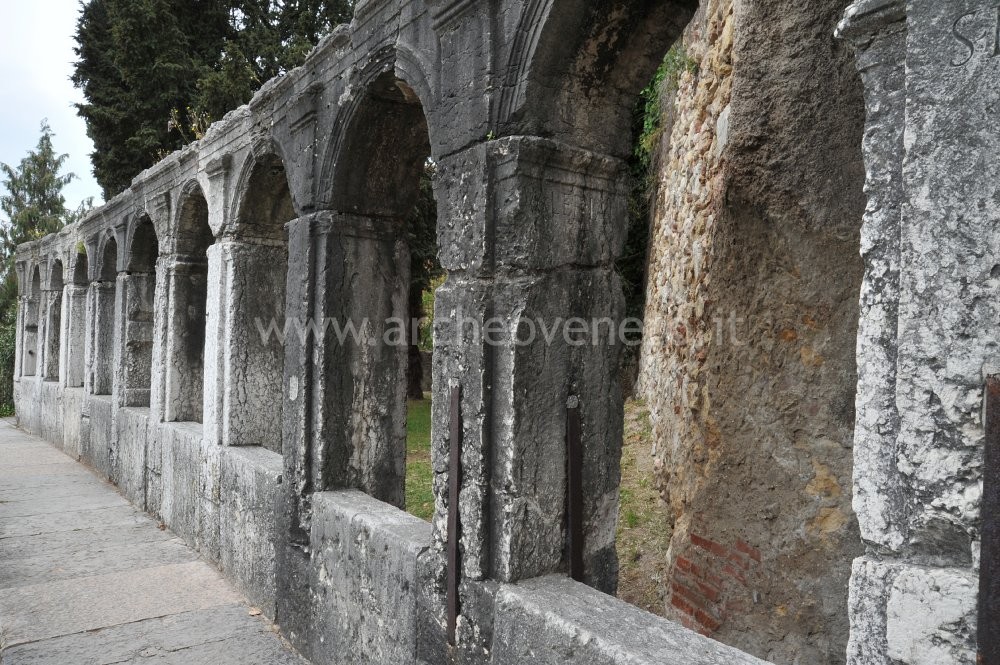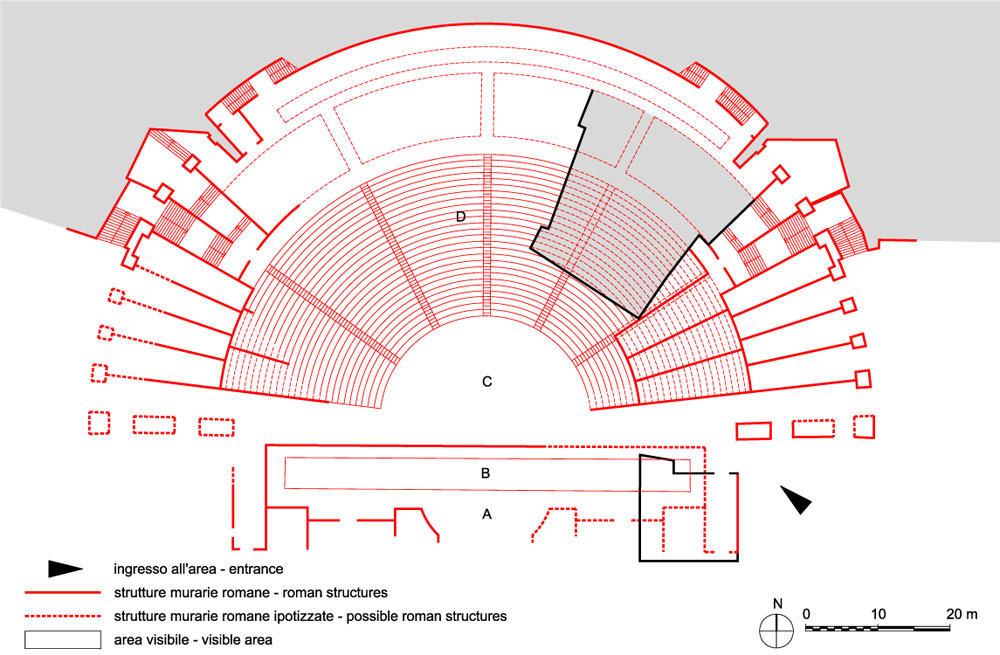|
|
File
Roman theatre – Verona
|
Regaste Redentore 2 – 37129 Verona (VR)
– Fax 045 8010587 |
  |
|
Summary

The Roman theatre of Verona was built around the end of the I century B.C. Its visible remains today include the stage, the orchestra, the auditorium and some galleries on two subsequent levels together with a top corridor.
History of research
The area of the Roman theatre was abandoned in ancient times and it was then occupied by various civil and religious buildings. The theatre was rediscovered between the XVIII and the XIX century by A. Monga, who carried out the first archaeological investigations by demolishing some of the buildings which had been built on top of it and by partially excavating the area. In 1904 the area was bought by the Municipality of Verona and, until 1914, the remaining buildings were demolished, the “cavea” was emptied and it was thus possible to carry out some partial reconstruction of the structures.
Urban and geographical context
Verona is located along the Adige river, where this enters in the Po plain, at about thirty kilometres east to the Garda lake. Its altitude is 59 metres above sea level and it is placed at the basis of the Lessini mountains. This archaeological area is located in the modern city centre of Verona. With respect to the Roman settlement, this place was located on the left bank of the Adige river, in an area that was far away from the forum and which was fully renovated during the I century B.C.
Chronology
I B.C. (end) |

 The remains of the stage (A) include the eastern substructures and the two lateral rooms to access the stage. Originally the stage must have been articulated into three doors, of which the central one was curved whereas the other two were incorporated into rectangular niches. The elevation of the “frons scenae” was decorated by applied columns. The remains of the stage (A) include the eastern substructures and the two lateral rooms to access the stage. Originally the stage must have been articulated into three doors, of which the central one was curved whereas the other two were incorporated into rectangular niches. The elevation of the “frons scenae” was decorated by applied columns.
Under the stage there was the orchestra pit (B), where it is possible to see squared stone block with holes for ropes to pass through and bring up and down the curtains through a counterweights system.
The orchestra (C) has a diameter of 15,30 metres and it is still partially paved with polychrome marbles. Between the orchestra and the auditorium there is a logline for channelling the rain water.
The “cavea” (D) is mostly reconstructed and lays partially on the hill slope and partially on radial support walls. The “cavea” is made of white limestone steps and it is vertically divided by five little stairs of red local marble. Horizontally a walkway (Latin: “praecinctio”) divided the “cavea” in two tiers of seats (Latin: “maeniani”). The 23 steps of the first, lower tier, have been reconstructed in 1912. Beyond the second tier of steps there was a gallery which was partially dug in the hill. On top of it there was another gallery with little arches, which is accessible through the western stairs.
|

Admission: Negli orari di apertura
Visitability: Interno
Ticket: Si
Price: Full price ticket: 4,50 Euro; Reduced price ticket for groups (over 15 people), the aged (over 60 years old), students (14 – 30 years old, only with students card): 3,00 Euro; Reduced price ticket for schools and children (8 – 14 years old; only accompanied): 1,00 Euro; Only price ticket: I Sunday of January, February, March, April, May, October, November, December: 1,00 Euro; Residents in the municipality of Verona, 65 years old: free ticket
 School access School access
Opening Days
| Tipology |
When |
Specs |
| Only |
Friday |
8.30-19.30 |
| Only |
Monday |
13.30-19.30 |
| Only |
Saturday |
8.30-19.30 |
| Only |
Sunday |
8.30-19.30 |
| Only |
Thursday |
8.30-19.30 |
| Only |
Tuesday |
8.30-19.30 |
| Only |
Wednesday |
8.30-19.30 |
The ticket is valid for the site and for the Archaeological Museum
Recommended tour time (minutes): 60
 Toilet Toilet
Toilets of the Civic Museum
 Brochure Brochure
Guide a stampa
Brochure and guide-book, available at the entrance to the Museum
 Guided Tours Guided Tours
For guided tours to groups of adults, please refer to the several associations of authorized touristic guides in Verona.
 Educational activities Educational activities
Dal lunedì al venerdì: ore 9.00-13.00 e 14.00-16.15
Tel 045 8036353 – Tel/fax 045 597140 – Fax 045 8000466
aster.segreteriadidattica@comune.verona.it – www.didamusei.it
Prezzo: 1 ora: 46,00 €; 1,5 ore: 56,00 €; 2 ore: 66,00 €; 3 ore: 92,00 €; 1 giornata: 138,00 €.
Eventuali offerte saranno comunicate al momento della prenotazione.
I percorsi didattici sono offerti gratuitamente (fino ad esaurimento della disponibilità) alle Scuole del Comune di Verona. L’ingresso ai musei è a pagamento, con la tariffa ridotta per le scuole.
 Library and documentation centre Library and documentation centre
| Beschi L. 1960, Verona romana. I monumenti, in Verona e il suo territorio, I, Verona, pp. 369-352. |
| Franzoni L. 1961, Nuovi elementi per la conoscenza del teatro romano di Verona, Verona. |
| Mangani E., Rebecchi F., Strazzulla M.J. 1981, Emilia, Venezie (Guide Archeologiche Laterza), Bari, pp. 164-165. |
| Basso P. 1999, Architettura e memoria dell’antico. Teatri, anfiteatri e circhi della Venetia romana, Roma, pp. 298-306. |
| Archeologia a Verona 2000, a cura di Bolla M., Milano, pp. 13-28. |
| Tosi G. 2003, Gli edifici per spettacoli nell’Italia romana, Roma, pp. 537-540. |
| Bonetto J. 2009, Veneto (Archeologia delle Regioni d’Italia), Roma, pp. 448. |
|



 School access
School access Toilet
Toilet Brochure
Brochure Guided Tours
Guided Tours Educational activities
Educational activities Library and documentation centre
Library and documentation centre











